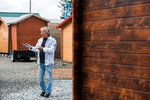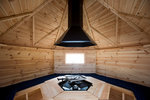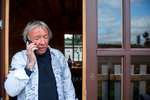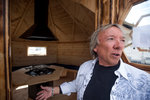




The houses on Ron Blair’s “Tiny Street of Dreams” are dwarfed by the rows of white camping trailers looming behind them, but as a conduit to African delegates and a budding reality TV show, the houses have dominated his business in ways he never imagined.
Blair, who owns Blair’s I-5 RV just off the Grand Mound exit and has been in the RV industry for 40 years, said he was sitting in his office when a “guy dressed like a phone book salesmen” walked in with a pamphlet of European designs of tiny cottages.
His salespeople accepted the paperwork but ushered the guy out before Blair could meet with him, but he did look through the documents.
“I saw the vision immediately, but I didn’t see how big (the market) was going to be,” Blair said, reflecting on the day five years ago when he decided to enter the tiny house industry.
He jumped into the fray with his tiny house company Global Green Concept Designs. He sells the homes through his retail outlets called “Tiny Street of Dreams.”
Within the last year, Blair has met with government officials from Kenya through the African Chamber of Commerce of the Pacific Northwest to discuss trade and housing, and he’s started establishing numerous retail franchises across the United States.
He also has a reality TV show in the works.
Blair won’t name which network it’s going to be on, but said the concept is about 24 people who document their efforts to build and furnish their own mobile tiny homes and later compete for $100,000.
Although he’s been involved with small homes for five years, he said the momentum is just now starting to build.
“We’re just at the very beginning stages of the tiny homes movement,” he said.
Tiny homes are just what the name implies.
Inside, the house is set up like a studio or one-bedroom apartment, but utilizes storage space the way a camp trailer might. On the outside, they often have a sloped roof, a deck and occasionally flower boxes hanging off the windows.
Initially popular within the environmental and the living-off-the-grid crowds in the early 2000s, tiny houses — up to 1,000 square feet, but usually much less — started as an antithetical response to enormous houses in bloated suburban developments and the consumer culture that surrounds it all.
But for those without the carpentry skills or money to build a house, they were a dream just out of reach.
However, within the last few years, architects have created sophisticated tiny home designs, and builders started leading workshops, Meanwhile, manufacturers started producing kits that can be assembled in just a few days.
Today, cities such as Seattle, Olympia, Portland and Eugene are seeing tiny homes as a stepping stone solution to get people off the streets and reintegrated into society.
Olympia’s tiny home community, Quixote Village, consists of 30 tiny cottages that can be rented out to adults for as long as they need, so long as they are working toward a goal such as improving their mental or physical health or getting a job or education.
Blair’s kits have wooden boards that stack like Legos and intersect like Lincoln Logs. They’re not wired or plumbed, but it can be done.
“My 12-year-old daughter built a tiny house out of one of our kits,” Blair said. “There are programs out there where a person can build a tiny home in a year, but most people want turn-key. We made it so it can be done in a matter of hours rather than a year.”
In recent years, the tiny house appeal has broadened. Blair said his clients vary from people wanting to build a backyard mother-in-law cottage or an off-house “man cave” to people who want to put a tiny home on a trailer and be mobile.
To evangelize his business, Blair has spent the last few years regularly traveling around the western U.S. towing a mobile tiny home. He said hardly anyone bats an eye when they see an RV going down the highway, but the little house on wheels draws a crowd wherever he stops.
“I’ve had people stop me at gas stations and say they’ve been following me for 200 miles down the highway wanting to talk to me,” he said. “Everybody smiles when they see a tiny house, even the grumpiest people smile.”